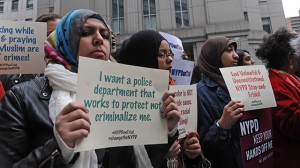This article originally appeared at The Indypendent.

A crowd gathers at a press conference and rally in front of Manhattan federal court to vocalize their objection to the stop and frisk policy by the police Department Wednesday, March 27, 2013, in New York. (AP Photo/ Louis Lanzano)
During his New York mayoral bid, Bill de Blasio presented himself as “the only candidate to end the stop-and-frisk era that targets minorities.” His opposition to stop-and-frisk became a defining feature of his campaign, and his multiracial family and his teenage son’s now-legendary afro did much to bolster the image de Blasio was trying to construct: that of a progressive populist for a diverse New York. Needless to say, he overwhelmingly won the African-American and Latino vote.
But after emerging victorious from the election, he added a qualifier to his tune: the goal de Blasio now talks about is ending “unconstitutional” stop-and-frisk. The number of stop-and-frisks occurring on the streets of New York has already dropped sharply in the past year, but de Blasio is inheriting a city that is scarred by the aggressive policing of the Bloomberg administration. So when the mayor-elect tapped William Bratton as his police commissioner on December 5, many stop-and-frisk opponents reacted warily and some expressed vocal opposition. Bratton served as New York’s top cop from 1994 to 1996 under Rudolph Giuliani; during that time, he implemented the “zero tolerance” policing tactics that paved the way for the stop-and-frisk abuses of the Bloomberg/Kelly years.
Much like his new boss, Bratton has come out in favor of making sure that stop-and-frisk is carried out constitutionally. But he has also called the tactic “an essential tool of policing,” and prophesized that “you do away with it, and your cities are overrun with crime.” Between 2002 and 2008, during Bratton’s stint as LAPD commissioner, the annual number of pedestrian stops nearly doubled; meanwhile, the annual number of both pedestrian and motor vehicle stops jumped by 49 percent, from 587,200 to 875,204.
“It’s like asking an arsonist to help you put out fires. You don’t ask the person who is the architect of racial profiling, stop-and-frisk to come back and not put a stop to it,” declared outgoing East New York Councilmember Charles Barron at a press conference the day Bratton’s appointment was announced. He vowed to launch a grassroots campaign to oust the commissioner-designate.
Reactions from other opponents of stop-and-frisk have been more measured, with Brooklyn Councilmember Jumaane Williams stating that he is “cautiously optimistic” about de Blasio’s choice and the Center for Constitutional Rights (CCR) saying, “We hope Bratton’s appointment is not a signal from de Blasio that the NYPD will be ramping up so-called ‘broken windows’ policing, surveillance and numbers-driven policing.”
After 12 years of Raymond Kelly at the helm of the NYPD, it may come as a balm to hear an incoming mayor and police commissioner emphasize the importance of constitutional principles. But the last few decades have seen state and federal court rulings weaken limitations on stop-and-frisk. In the end, the reality of what it will mean to end “unconstitutional” stop-and-frisk may fall far short of the rhetoric.
What the Courts Have Said
In 1968, the US Supreme Court handed down the landmark decision Terry v. Ohio, which permitted police to stop an individual based on a reasonable suspicion that the suspect was involved in criminal conduct. In 1976, New York’s Court of Appeals, interpreting New York’s constitution, said police need a “reasonable, articulable suspicion” of criminality to justify a stop and frisk. This standard is short of “probable cause,” which is needed to justify an arrest.
But subsequent legal cases have carved out numerous exceptions to these bedrock principles, a process that has weakened them and given local police extremely wide latitude in deciding what constitutes suspicious behavior. Leaving it up to police officers and then to judges to decide whether behavior was “suspicious enough” is an entirely subjective standard; at the same time, it has meant that the crucial decisions were made on a case-by-case basis, out of context from the rest.
That is why CCR’s Floyd v. City of New York class-action lawsuit was so audacious and so necessary. No one else was working to show a pattern of discrimination. To prevail in showing that the NYPD’s stop-and-frisk policy was a violation of the Fourteenth Amendment’s equal protection clause — that all people are guaranteed the same protection of and under the laws — they had to amass statistical evidence showing that racial minorities were disproportionately affected, that the stops didn’t help identify the true criminals and that the justifications cited by police were bogus. Besides the egregious examples that befell their named plaintiffs, they needed an expert witness to pull it all together to show a pattern of racialized suspicion.
An earlier CCR victory in the 2003 case of Daniels v. City of New York led to a requirement that police officers keep records of each stop. The form used by the NYPD, the UF-250, required only that the officer check off a box indicating the reason for it. The choices were “furtive movements,” “fits the description,” “casing a location,” “acting as a lookout,” “evasive response,” “suspicious bulge,” “high crime area” and “other.”
Columbia law professor Jeffrey Fagan conducted a review of these forms and, accepting the officers’ word at face value, was able to classify the stops as “apparently justified,” “apparently unjustified,” or “inconclusive.” In Fagan’s sample, 36 percent of the forms did not identify a suspected crime. “Furtive movements” or “high crime area” were checked off on 40 percent. Since only about 10 percent of stop-and-frisks led to a summons or an arrest (and even fewer to a conviction), the court was able to see a pattern of wrongful and needless stops that infringed on the rights of racial minorities. In August, Judge Shira Scheindlin of the Southern District of New York ruled the stop-and-frisk program unconstitutional and ordered immediate changes to it.
The road to this incredible civil rights victory, which de Blasio says he would let stand, was long and bloody. If the mayor-elect drops the Bloomberg administration’s appeal of Judge Scheindlin’s decision, Bratton will nonetheless still need to fully implement her ruling, which requires some precincts to wear cameras to film civilian encounters for a one-year period. Scheindlin’s decision would impose a joint remedial process between CCR and the NYPD, to include two community meetings in each borough “to take the pulse of the community,” and to report back to her for possible further remedies.
Let’s hope for — but not assume — the best of intentions on the part of de Blasio and Bratton. We cannot allow this epic legal victory to be squandered by inaction.


